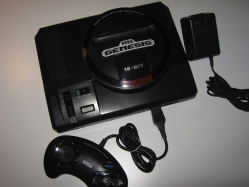Sega Genesis System Console (NTSC-USA)

Autopsy:
from Wikipedia:
The Sega Genesis is a fourth-generation video game console developed and produced by Sega. It was originally released in Japan in 1988 as Mega Drive (メガドライブ Mega Doraibu?), then in North America in 1989 as Sega Genesis, and in Europe, Australia and other PAL regions in 1990 as Mega Drive.
The reason for the two names is that Sega was unable to secure legal rights to the Mega Drive name in North America. The Sega Genesis is Sega’s third console and the successor to the Sega Master System with which it has backward compatibility when the separately sold Power Base Converter is installed.
The console was released in Japan as Mega Drive on October 29, 1988. Sega announced a North American release date for the system (as Sega Genesis) on January 9, 1989. Sega initially attempted to partner with Atari Corporation for distribution of the console in the US, but the two could not agree to terms and Sega decided to do it themselves. Sega was not able to meet the initial release date and US sales began on August 14, 1989 in New York City and Los Angeles. The Sega Genesis was released in the rest of North America later that year on September 15, 1989 with the suggested retail price of $189.99, $10 less than originally planned, and also $10 less than the competing TurboGrafx-16.
The Mega Drive’s CPU is a 16/32-bit Motorola 68000. The maximum addressable memory is 16 MB from the ROM ($00000000-00400000 – 4 MB), to the RAM ($00FF0000-00FFFFFF – 64 KB). The 68000 runs at 7.61 MHz in PAL consoles, 7.67 MHz in NTSC consoles. The Mega Drive also includes a Zilog Z80, which serves as secondary processor along with allowing complete Master System compatibility with only a passive adapter. The initial Mega Drive models used a Hitachi-made HD68HC000, while the Mega Drive 2 and later models used a Motorola MC68HC000, both fabricated in CMOS.
source: wikipedia












Recent Comments